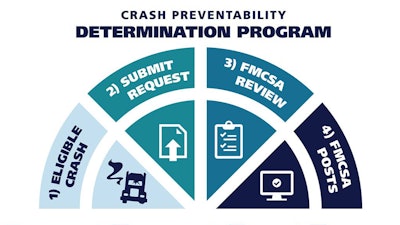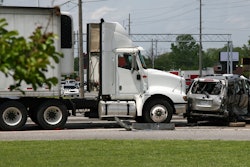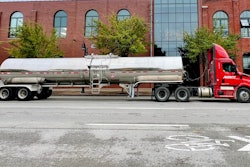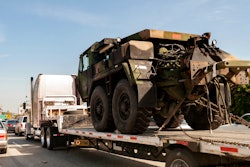
The Federal Motor Carrier Safety Administration is moving ahead with plans to update its Crash Preventability Determination Program (CPDP), which allows motor carriers and drivers to submit crashes for evaluation of whether the crashes were preventable or not.
FMCSA went live with the CPDP in 2020, which allowed crashes deemed not preventable to be removed from use in a carrier’s Crash Indicator Behavior Analysis and Safety Improvement Category (BASIC) percentile ranking in the CSA Safety Measurement System.
In 2023, FMCSA proposed to change some of the 16 existing crash types and add four new types to expand the program "to review even more crashes each year for preventability.” The agency received 60 comments on the April 2023 proposal, 53 of which were directly related to the proposed changes. FMCSA noted comments “largely supported the proposed changes.”
[Related: FMCSA proposes changes to crash preventability program]
FMCSA also received some comments asking for changes to the proposal. The agency’s response to those requests are as follows:
Changes to existing crash types
FMCSA’s proposal to update the CPDP included changes to 11 of the 16 existing crash types eligible for review. The full list of proposed crash type changes can be found here. FMCSA said based on the comments it received, it will modify the list of eligible crash types as proposed last April.
“These changes will encompass more scenarios, such as where the CMV was not the striking vehicle and multi-vehicle crashes,” the agency said.
New crash types
The agency also proposed to add four new crash types:
- CMV was struck on the side by a motorist operating in the same direction.
- CMV was struck because another motorist was entering the roadway from a private driveway or parking lot.
- CMV was struck because another motorist lost control of their vehicle. The Police Accident Report (PAR) must specifically mention loss of control either in the citation, contributing factors, and/or PAR narrative.
- Perhaps most significantly for carriers utilizing dashcams, any other type of crash involving a CMV where a video demonstrates the sequence of events of the crash.
FMCSA said 26 commenters supported the inclusion of these four crash types in the program, noting that the fourth crash type generated the most commentary. Several commenters addressed challenges with the DataQs system in uploading videos and requested that the system be updated to allow upload of more file types and larger file sizes.
The agency noted in its responses to these concerns that in September 2023, the file size limitation in DataQs was increased to 25 MB, and the system accepts most commonly used file formats.
[Related: House committee passes anti-freight fraud bill and DataQs reform]
The American Trucking Associations, J.B. Hunt (CCJ Top 250, No. 3) and an anonymous commenter expressed concerns with FMCSA’s handling of video files. ATA contended that FMCSA should clarify that any video evidence should be reviewed, not just that from an onboard video recorder. Commenters referenced other video source types -- surveillance footage, cell phone video, and etc.
ATA also asked that FMCSA “clarify the expectation for demonstrating the sequence of events of the crash ... FMCSA should not expect, nor require, video evidence in the hours and days leading up to the crash.”
The agency clarified that video footage submitted with the CPDP request is expected to include the full sequence of the crash, but submitters should not include video files of hours or days preceding the crash.
ATA also asked that FMCSA “take steps to ensure data privacy when submitting video evidence and ensure that any video submissions are permanently deleted after a determination has been made.” J.B. Hunt concurred that the company believes video submissions should be treated as confidential business information and exempt from public disclosure.
In addressing privacy concerns, FMCSA said all files uploaded to DataQs are encrypted and that information submitted to the CPDP is not used for enforcement purposes.
FMCSA also noted that it received requests to add a number of additional crash types to the system.
After reviewing the additional requests, FMCSA said it determined that “many were already incorporated in the new and modified crash types proposed in the April 2023 notice,” adding that the agency doesn’t plan to include any additional crash types other than what was proposed last Spring.
“The eligible crash types listed are less complex crash events that do not require extensive expertise to review,” FMCSA said. “Crash scenarios not specifically listed as eligible may be accepted to the program if a video showing the sequence of the crash is submitted with the request.”
The final list of the 21 crash types eligible for review can be seen here, or on FMCSA's CPDP website.
CPDP submission process
The Owner-Operator Independent Drivers Association (OOIDA) and another commenter, Bryan Henry, asked that FMCSA proactively review crashes for preventability and remove the requirement for the motor carrier or driver to submit a request.
As OOIDA put it, “Given the CPDP data over the last five years, the burden should now fall on the agency, rather than the submitter, to overturn qualifying crashes. ... We believe transferring the burden to the agency to determine crash preventability will help keep safe, experienced motor carriers in business and will also reduce the current backlog of CPDP submissions.”
FMCSA declined to grant OOIDA’s request, noting that “the CPDP process will remain initiated by a request from the motor carrier, driver, or authorized representatives. The burden is on the submitter to provide compelling evidence that the crash is eligible and not preventable.” The agency added that submitters are encouraged to provide additional documentation supporting their request, including videos, pictures and court documents.
“The crash data fields that are submitted to FMCSA in the Motor Carrier Management Information System (MCMIS) are a subset of the information that is available on the PAR,” the agency said. “FMCSA does not have direct access to PARs or other supporting documentation about a crash; and a preventability determination requires more information than is available in MCMIS.”
Additionally, two commenters, including transportation attorney Hank Seaton, said they believe that the CPDP lacks due process. Regarding these comments, FMCSA said it doesn’t “believe that using recorded crashes for safety assessment and enforcement workload prioritization purposes constitutes deprivation of a property interest for which due process is required.” The agency added that the “program does not amend any prior legislative rules, nor does it provide a basis for any new enforcement actions.”
FMCSA concluded that “crash preventability determinations made under this program thus will not affect any carrier's safety rating or ability to operate. FMCSA will not issue penalties or sanctions on the basis of these determinations, and the determinations do not establish any obligations or impose legal requirements on any motor carrier. These determinations also will not change how the Agency will make enforcement decisions.”
FMCSA also noted that the determinations do not establish liability, fault, or negligence by any party.
[Related: How to DataQ to challenge a violation]
Document requirements
Despite requests from Siskiyou Transportation and ATA to accept requests that do not include a Police Accident Report (PAR) but have other crash information reports, FMCSA said it will continue to require a PAR issued from a law enforcement agency as a condition of eligibility for the program.
Impacts to SMS and PSP
OOIDA and several other commenters recommended to FMCSA that the agency modify how crashes submitted to the program, and those determined “Not Preventable,” are handled in the Safety Measurement System (SMS) and Pre-Employment Screening Program (PSP). FMCSA didn’t propose any changes to the use, display, and notations of determinations from the CPDP with these systems.
OOIDA and the National Motor Freight Traffic Association (NMFTA) wanted FMCSA to remove crashes determined “Not Preventable” entirely from SMS. TMC Transportation asked for a 30-day grace period before a crash is posted to SMS so the carrier has an opportunity to request a preventability review of the crash. Several other commenters asked FMCSA to suspend the use of crashes submitted to the CPDP in SMS calculations while the requests are under review.
FMCSA said, however, that it is not making any changes to the way determinations from the CPDP are used, displayed, or notated on SMS and PSP at this time. “FMCSA will continue to list Not Preventable crashes on the public SMS website,” the agency said. “However, the crash will continue to appear in a separate table from all other crashes.”
Additionally, nonpreventable crashes will not be included in a carrier’s Crash Indicator BASIC, and crashes found to be “Preventable” and “Undecided” will continue to be used the calculation of the Crash Indicator BASIC.
“The Agency believes that the public display of all crashes, regardless of the preventability determination, provides the most complete information regarding a motor carrier's safety performance record,” FMCSA added.
[Related: Nonpreventable-crash DataQs of utmost importance for small fleets, owner-ops]
Implementation of updated crash types to the CPDP
FMCSA said in its April 2023 proposal that it expected to have a start date for new crash types added to the CPDP, and that these would not be retroactive, meaning crashes that fell into the new categories before the start date of the updated CPDP would not be eligible for review. The agency received several comments requesting that FMCSA apply the eligibility of new crash types retroactively.
FMCSA is continuing to decline allowing retroactive eligibility “to ensure that crashes that occurred during the same period are analyzed with a consistent set of criteria.”
FMCSA will accept DataQs requests for data review (RDRs) for the new and updated crash types for crashes that occur on or after December 1, 2024.
Wrong-way crash requests
A handful of commenters asked that FMCSA expand the eligibility requirements for the crash type “CMV was struck because another motorist was driving in the wrong direction.” The current criteria requires that a vehicle is traveling in the wrong direction (such as northbound in the southbound lanes) and is completely in the wrong lane, not just partially across the center line.
Six commenters asked that FMCSA change this to allow for crashes where the other vehicle was partially across the center line as eligible under this crash type.
FMCSA ultimately decided to stay with the current criteria for the “wrong direction” crash type and will not allow for partial crossing of the center line as an eligible crash type.
“The crash types that are eligible for the CPDP are less complex crash events that do not require extensive expertise to review,” FMCSA noted. “However, the addition of the new crash type, where a CMV was involved and a video demonstrates the sequence of events of the crash, may allow for partial crossing of the center line types of crashes.”
[Related: FMCSA proposes federal system for third-stage DataQs appeals]














